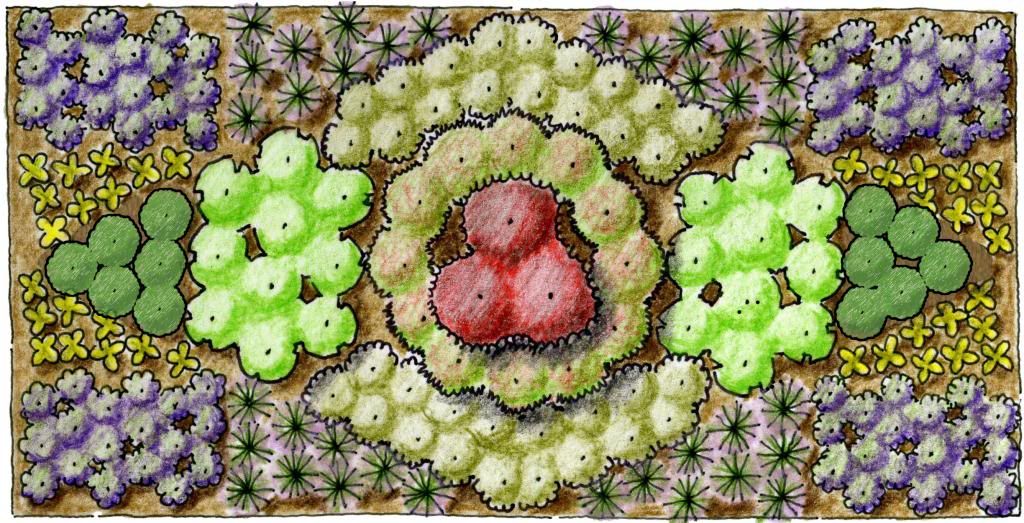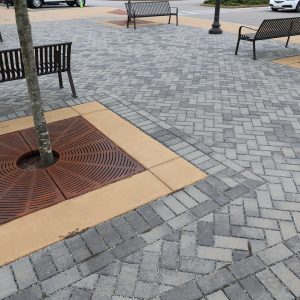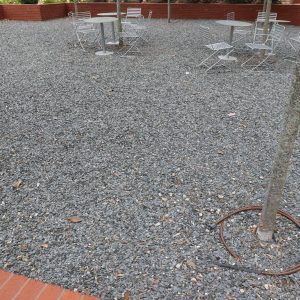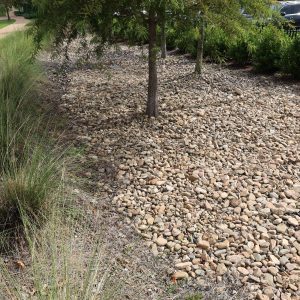Landscaping

Porous Is Smart
Walkways, patios, and driveways are typically impervious. Excess water running off-site transports pollutants to local waterways. When infiltration is allowed, soil can filter many pollutants, such as fertilizers, pet waste, and motor oil.
You Will Need:
Permeable pavers
Gravel
Brick
Mulch
- Add more permeable/porous surfaces. Change your driveway, walkway, or patio (or a portion of it) to permeable pavers, gravel, or bricks. These will allow infiltration and maintain your desired function.
- Porous materials include bricks, gravel, turf block, mulch, and pervious concrete. Some are less expensive than other paving materials.
- Patios of pavers or bricks can be more decorative than poured concrete. Spacing the joints and filling them with crushed aggregate enhances their patterns and increases water infiltration.
- Consider small modifications to intercept stormwater.
- Add a dividing strip of grass or pea gravel to your driveway. If choosing gravel, make sure that it remains contained and separate from any areas to be mowed.
- Add breaks in concrete patios. Insert bricks set in sand or aggregate, or plant the breaks with low-growing evergreen plants.
- Permeable pavers are set in sand, gravel, a raised-grid structure, or a combination of these.
Reduce Pollutants
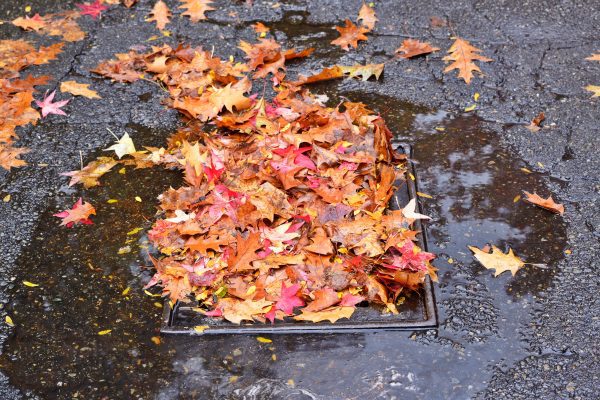
Storm drains can direct pollutants to nearby waterways.
Stormwater runoff is water flowing off impervious or water-saturated surfaces. This runoff carries nonpoint source pollution (NPS) that may include loose fertilizer, pet waste, loose soil, metals, and trash.
You Will Need:
Soil Test
Research
Slow-Release Fertilizer
Trash Bag
Broom
Trash Pickup Day
- Avoid overfertilizing your lawn. Soil test before fertilizing with phosphorus. If plenty is in the soil, your plants do not need more. Only add nitrogen to growing green plants, and read the label to learn the right amount to apply. (See “Alabama Smart Yards Recipe for Care & Maintenance, Fertilize with Care,” ANR-2872-C.)
- Use slow-release fertilizer that is recommended for all soil types and planting areas. If you have sandy soil and the soil test recommends a large amount of nitrogen, divide this amount into multiple applications over several weeks.
- Pick up pet waste. The bacteria and nutrients pollute streams and lakes.
- Clean up oil spills from motorized gasoline equipment. Spread cat litter over the oil to absorb it, sweep it up, bag it, and throw it in the trash.
- Sweep up grass clippings, fertilizer, and loose soil. Remove the excess from your driveways and streets before the rain does. Sweep these into lawns, planting beds, or a compost pile.
- Do not sweep yard waste into a storm drain. The drains lead directly to streams, rivers, and lakes.
- Remove litter from streets. Prevent it from washing into storm drains where it travels to streams and rivers.
Rain Gardens
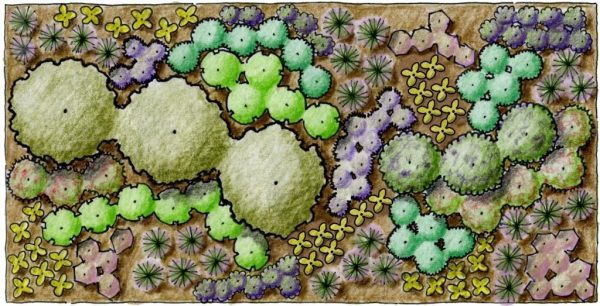
Example of a rain garden planting from “How to Install a Rain Garden,” available on the Alabama Extension website.
Rain gardens are an attractive way to slow and soak in stormwater before runoff. These working gardens filter pollutants, host a variety of plants, attract wildlife, and do not host mosquitoes when designed properly.
You Will Need:
Research
Shovel
Measuring Tape
Calculator
Paper and Pencil
Mulch
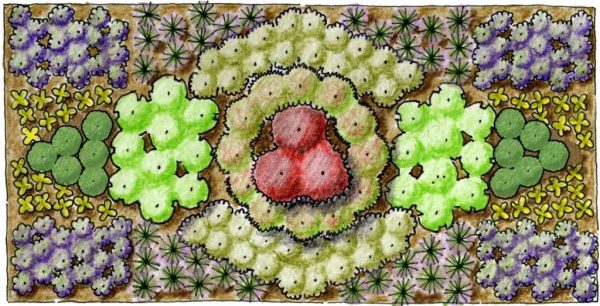
Example of a rain garden planting from “How to Install a Rain Garden,” available on the Alabama Extension website.
- Know the municipal and neighborhood requirements—property lines, permits, utilities, etc.
- Watch the water flow on a rainy day. Is there a low spot where water is already directed?
- Be sure that any potential site is at least 10 feet away from the home’s foundation.
- Test the potential site’s infiltration rate. A rate of 1⁄2-inch per hour is recommended.
- Map and measure the total impervious area that drains to the rain garden site. An effective garden size is 10% of the total impervious area.
- Use appropriate plants. They should be drought tolerant and able to withstand wet soil for 24 to 48 hours.
- Good choices in Alabama include Stokes aster (Stokesia laevis), blackeyed susan (Rudbeckia hirta), and purple coneflower (Echinacea purpurea).
- Maintain regular care as required for other garden areas—weeding, pruning, and watering as needed.
- Leave dormant plants in the winter for seasonal interest and to support wildlife.
- Consider using shredded wood mulch, which stays in place well.
- Find more information on the Alabama Extension website, www.aces.edu.
Install Rain Barrels
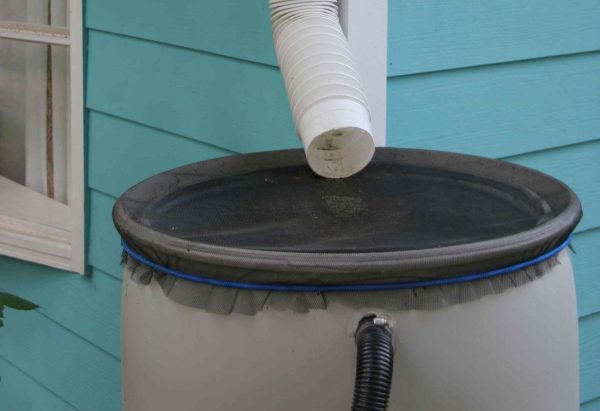
Rain Barrels are an excellent way of collecting an on-site resource and slowing the speed of water flowing off property.
Rain barrels typically tie into a home’s roof gutter system. They collect water, save money, and reduce stormwater runoff. Large plastic barrels are available in many designs and sizes.
You Will Need:
Large Plastic Barrel
Pipe
Fittings
Concrete Blocks
3⁄4′′ Drill Bit
1⁄2′′ Brass Spigot
- Choose a barrel that is at least 42 gallons.
- Use barrels with flat bottoms because they are more stable.
- Remember that barrels either have sealed lids or lids that can be removed. Those with sealed lids typically have two small round threaded openings. These can be used to clean out the barrel or attach PVC fittings for incoming and outgoing water.
- Install the barrel so it will be raised above the ground to allow room for connection to the outgoing spout. Concrete blocks work well.
- When installing the barrel, ensure that it has an overflow outlet that directs water away from the foundation of your house.
- Paint white plastic barrels so they won’t deteriorate quickly in the sun. Darker barrels tend to reduce algae growth. Be creative and paint your barrel with paint suitable for plastic surfaces.
- Make sure the downspout fits tightly to avoid creating mosquito-breeding habitat. If your rain barrel is open at the top, use a larvicide dunk containing Bacillus thurigiensis (Bt) to kill mosquito larvae safely.
- Drain and clean the barrel if algae grows in it.
- Need more water? Consider a cistern. Water from a roof is filtered, collected, and stored in a reinforced concrete, metal, fiberglass, or plastic container. Cisterns can be placed underground or at ground level but may require pumps for easier use.
- Find more information on the Alabama Extension website, www.aces.edu.
Grass-Lined Swales
A grass-lined swale is simply a planted dip in the ground. Swales catch, hold, and filter polluted stormwater runoff. Convert rock-lined, concrete-lined, or eroding ditches to improve the health of nearby waterways.
You Will Need:
Research
Ground Cover of Choice
- Maintaining vegetative ground cover under trees can help decrease soil erosion. Remember that most turfgrass species grow best in full sun. Consider other plants such as Ajuga, wild ginger, hosta, mondo grass, pachysandra, and phlox.
- A densely growing turfgrass or ground cover is especially useful in capturing, filtering, and recharging groundwater. (See “Alabama Smart Yards Recipe for Care & Maintenance, Mowing Lawns,” ANR-2872-B)
- Consult a landscape architect or stormwater engineer for design assistance. Minor alterations to the lay of the land do not require permits or experts, but any major work will require regulatory review.
- Check with the Alabama Department of Environmental Management (ADEM) before making changes to shorelines of streams, lakes, rivers, or beach fronts.
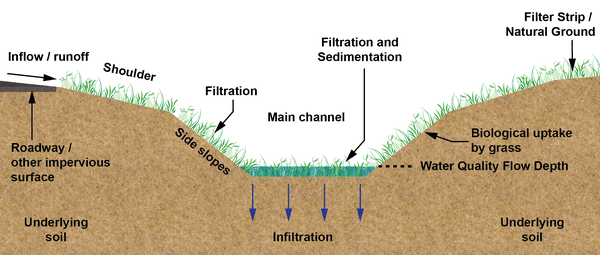
Grass-lined swales direct and filter stormwater runoff and reduce erosion. This illustrates a typical cross section and its stormwater treatment processes. Image used with permission, NCSU-BAE (2020). Ekka, S. & Hunt, B. Swale Terminology for Urban Stormwater Treatment (AG-588-26).
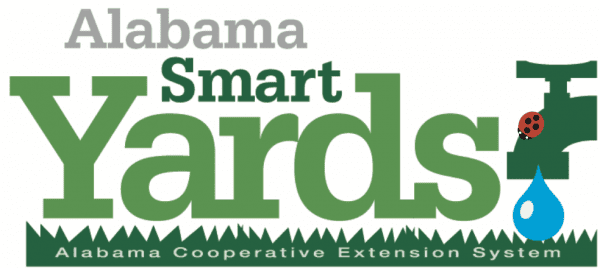
 Kerry Smith, Administrator, Outreach Programs, Horticulture, Auburn University
Kerry Smith, Administrator, Outreach Programs, Horticulture, Auburn University
New July 2022, Reduce Runoff– Smart Yards Recipe Series, ANR-2872-D

